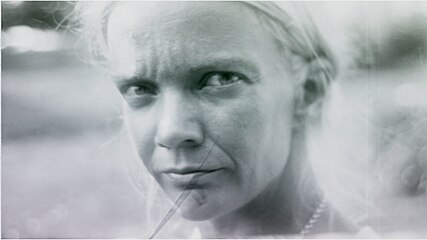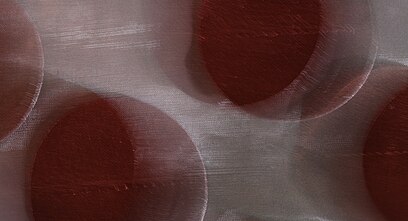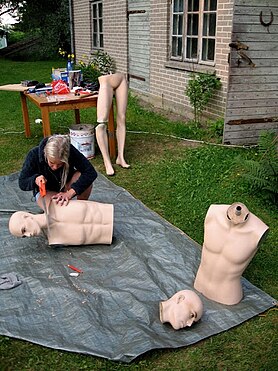Draft:Niina Suominen
 | Review waiting, please be patient.
This may take 2 months or more, since drafts are reviewed in no specific order. There are 2,342 pending submissions waiting for review.
Where to get help
How to improve a draft
You can also browse Wikipedia:Featured articles and Wikipedia:Good articles to find examples of Wikipedia's best writing on topics similar to your proposed article. Improving your odds of a speedy review To improve your odds of a faster review, tag your draft with relevant WikiProject tags using the button below. This will let reviewers know a new draft has been submitted in their area of interest. For instance, if you wrote about a female astronomer, you would want to add the Biography, Astronomy, and Women scientists tags. Editor resources
Reviewer tools
|
Niina Suominen (born 1973, Masku Finland) is a Finnish visual artist working with moving images and experimental film. Her artistic practice builds upon experimentation and improvisation both in terms of content and technical practices[1].

Early life and education
[edit]Suominen was born in Masku in the countryside of Southwest Finland. She has the eduaction of a blacksmith artisan and has worked at a Finnish wildlife zoo as animal caretaker. After a one year course in animation on 8mm film in Kokkola in 1998, she found enthusiasm for this art form and came back to art education relatively late in life. She graduated in 2004 with a BA from Turku University of Applied Sciences, The Academy of Arts. Suominen studied under the renowned Estonian animation artist Priit Pärn. Suominen lives and works in Merimasku in the Southwestern archipelago of Finland[2].
Memberships
[edit]Suominen was one of the three original founding members of Turun Anikistit ry, the association of animation artists based in Turku, Finland founded in 2003. She was the association's chairperson for the first years.[3] Suominen is a member of Artists' Association MUU, AV-arkki - The Centre for Finnish Media Art, Filmverkstaden rf. and Photographic Centre Peri.
Works
[edit]Suominen mainly works with moving images. She has also worked with panoramic projections and installations[4]. In 2023 she worked as communal artist in Pargas and Nagu in the Swedish speaking Turku archipelago[5].
In her film Smoking Spot (2025) the images were produced by manually effecting the images during the shooting. Additional images were shot on 16mm film. Smoking Spot is an experimental documentary about the loss of the communal smoking area as societies strive to become smoke-free little by little. The music was composed by Finnish experimental electronic music composer Lau Nau.
Diabolus ex Machina (2024) was produced by capturing series of images from white screens with a handheld camera. The music for the piece was composed by Finnish experimental electronic music composer Sara Milazzo. The gallery premiere of Diabolus ex machina was at Galleria Huuto, Helsinki Finland[6].

For the experimental animation documentary about the cultural ways of dealing with women's feelings of hate and aggression Golden Headacher (2022) Suominen used textile and decor waste for visual material[7]. The music for the work was composed by Finnish composer Risto Ylihärsilä who has also contributed the music to some earlier works by Suominen.
Golden Headacher was awarded the Honorary Mention at the Rising of Lusitania – AnimaDoc Film Festival Szczecin, Poland. The juror Ewa Ciszewska accompanied the award with the words: "for exploring the theme of difficult female emotions in a form that is in tune with the tearful voice of the characters."[8]
Piotr Kardas wrote in the Zippy Frames article Great Animation Short Documentaries of 2023:
"A bold and honest disenchantment of motherhood, by exploring and expressing the negative and true female emotions associated with it. The women's testimonies correspond perfectly with the figurative-abstract visual layer, in which fragments of textile materials and "idyllic" glossy photos of children, which were popular in Scandinavia in the last century, constitute a bitter counterpoint to painful confessions."[9]
Suominen has worked with 16mm film material producing cameraless animation straight on film by exposing, painting, scratching, taping and chemically manipulating the material. This method can be seen in the works I Call Myself Sane (2010) and What Time Is? (2020) both of which also contain found footage. The music used for the latter was a new edit and mix of the track Mikä aika on? (1970) by the Finnish pioneering electronic music composer Jukka Ruohomäki[10]. Other images for What Time Is? were produced eg. by shooting moving metal plates, a bathroom mat and an insect net on an overhead projector frame by frame. The film has been circulating widely at international festivals[11].

I Call Myself Sane is based on a poetry music piece by author Teemu Hirvilammi and composer Ari Taskinen (published by Kustannusosakeyhtiö Sammakko on the compilation Asfalttia ja ruohoa 2001). The work was exhibited at Turku Art Museum[12]. I Call Myself Sane was awarded the 1st prize at Videoformes festival, Clermont-Ferrand, France[13][14].
Breaking Up Is Hard To Do (2015) is an object animation about the destruction of useless things given to us by our loved ones. The items get destroyed piece by piece, phase by phase by tearing, squeezing, riddling, burning and melting. The time lapse animation In Memoriam (2013) was shot in the middle of forests in abandoned houses and their surroundings. The theme of temporality and passing of time is reflected in the voice audio that was edited from a field recording of an auction of a hinterland farm estate. The work was exhibited at Pori Art Museum[15].
The experimental object animation shot outdoors A Finnish Fable 2011 (2011) is a homage to the Amercian experimental film maker Carmen D'Avino whose film A Finnish Fable (1960) also starred a mannequin. The film was shot outdoors. Therefore the weather and lighting conditions were beyond the control of the author which makes chance an essential stylistic ingredient of the work. The music was composed by Tuomas Toiviainen. The work has been exhibited at Turku Art Museum[16]. Suominen's film was awarded 1st prize Sphinx Award at the Videomedeja festival in Novi Sad, Serbia[17]. The jury opined about the film:
"This work explores the idea of excess free time or certain disorientation within the frame of late capitalist society. In addition, the author deconstructs stereotypes of “perfect” life in the Scandinavian countries: in a world where everything is precisely regulated human being has become a puppet. Also, it is worthwhile to consider the permeating witty music and animation in the final procedures that result in entertaining film which boldly explores the idea of free time."[18]
The film has also been interpreted to represent the present day situation amongst the severe environmental catastrophes: the human being has become hazardous waste in its former natural sourroundings. The human being is the artefact that doesn't fit into nature but puts it in peril. [19]
Good Stuff (2009) was a stylistic and artistic breakthrough and a major accomplishment as a work of animation. The process was long and painstaking. Using food categorised as biowaste as material and sourced from wastebins required collection rounds starting at 5am to procure approximately 200 kilograms of waste food each round. Afterwards the material was organised, cleaned, washed and sorted for shooting. Images were constructed by improvisation and the result is a continuous flow of dancing foodstuffs before their final perishing.[20] Good Stuff was awarded a Honorary Mention in the Political Animation Category at Klik! Amsterdam Animation Festival, Netherlands; a Honorary Mention at Nordic Glory Film Festival Jyväskylä, Finland; a Honorary Mention, at Kettupäivät film festival, Helsinki Finland and a Honorary Mention, Animatricks, Helsinki Finland. The film has also been used for educational purposes in the AV-Arkki series Mediataide kasvattaa.
English Lessons, College (2008) was an episode in the Turun Anikistit coproduction English Lessons[21][22]. The film was awarded a honorary mention at Tampere Film Festival, Finland. Suominen's episode was remarkable in the way that it was the first instance of her using organic material as the raw material for her work. In the film Suominen animated fish innards obtained from the fish industry for the episode that deals with the pressures of adapting to the demands of society.
Comeuppance (2007) was an episode in the Animaation Apupyörä co-production series Luonnon laki (The Law of Nature)[23][24]. It was done as a cutout animation and the music was composed by independent graphic designer, art director, musician and composer Tomi Leppänen. Room (2004) was an object animation shot on 16mm film. It was Suominen's graduation work from the Turku Arts Academy. Room was the way forward from traditional animation storytelling. Suominen used worn out household objects as protagonists in the film situated in a one room countryside cottage. The objects were animated objectively avoiding making them into easily recognizable characters. The objects and their relationships were dealt with in an abstract way without a regular plot leaving the interpretation to the viewer.
The other two school works are the minimalist puppet animation Polaris (2003) and the drawn animation Punctata (2002). Polaris was awarded the Prize of the Youth Jury at Tampere Film Festival[25].
She has also worked as animator in the Estonian animation artist Rao Heidmets's film Pärlimees[26] (2006) and Finnish artist Tommi Juutilainen's Ankkuri[27][28] (2007).
Style
[edit]Suominen has a diverse work and educational history before starting her artistic career. Handwork and working with physical objects are the constants of her professional work. Suominen's education and artistic background are in animation and working with film. In the field of animation her inspiration has been in the founding works of the pioneers of avantgarde animation from the 1920's to the 1950's, eg. the work of Len Lye, Oscar Fischinger and Walter Ruttman.[29]
The basic characteristics of Suominen's style and approach to film making can be seen in the waste food object animation Good Stuff: a powerful cultural or societal theme, the abscence of a linear narrative or story, the abstratct expressionism of vast, colourful, ever-changing surfaces in this instance borderning on action painting. She had tested working with organic material in English Lessons, College in which the fish innards are pushed, pulled and torn in abstract waves of colliding bursts.
Both of these works exemplify the way in which the feel of the material and handwork guide Suominen's improvisational process towards the finished work. This was demonstrated in Golden Headacher in which Suominen animated textile and decor waste to produce images akin to moving paintings.

A Finnish Fable 2011 took the principles of handwork, improvisation and chance to another direction: animating a heavy mannequin outdoors in the Finnish countryside cottage atmosphere required modifications to the mannequin and physical strength to manouvre it. The weather and lighting conditions were beyond the author's control thus bringing in a new dimension to the work.
Suominen has worked extensively with film material. Finnish artist Seppo Renvall has been instrumental as a mentor for Suominen's DIY approach to filmwork. She has exposed, developed, painted, scratched, taped and chemically manipulated film to produce moving images without a camera. In I Call Myself Sane the images are dreamlike and poetic whereas parts of What Time Is? can be seen as resembling pop art. I Call Myself Sane has been praised for its visuality as it weaves from painted abstraction to tight lines moulding into filmed forest imagery[30].
In Smoking Spot Suominen continued the film work by shooting black and white images on 16mm film. Material was also produced by manually effecting the images while shooting by holding and moving transparent objects between the lens of the camera and the target. Whereas in some of Suominen's films the movement can be seen as hyperactive at times, in Smoking Spot the atmosphere is serene and peaceful.
Diabolus ex Machina was done by shooting image sequences of white screens of cheap consumer electronics displays. The ominous feel of the work is augmented by the music by Sara Milazzo. Diabolus ex Machina is another instance of Suominen's approach to film making as producing moving paintings.
Distribution
[edit]Suominen's works are distributed by AV-Arkki - The Centre for Finnish Media Art and Raina Film Festival Distribution. Her works have been presented on Finnish national TV by Yle, including: Smoking Spot, Golden Headacher[31], Good Stuff, Punctata. Good Stuff has also been syndicated in Latin America by Turner Broadcasting via Kurzfilm Agentur Hamburg.
Filmography
[edit]| Film | Duration | Technique | Year |
|---|---|---|---|
| Punctata | 2'50'' | Drawn animation (16mm film). | 2002 |
| Polaris | 6' | Puppet animation (16mm film). | 2003 |
| Room | - | Object Animation (16mm film). | 2004 |
| Comeuppance | 3' | Cutout animation. | 2007 |
| English Lessons, College | - | Object animation. | 2008 |
| Good Stuff | 8'13'' | Object animation. | 2009 |
| I Call Myself Sane | 4'20" | Cameraless animation, 16mm film work, found footage. | 2010 |
| A Finnish Fable 2011 | 5'35'' | Object animation shot outdoors. | 2011 |
| In Memoriam | 6'26'' | Time lapse. | 2013 |
| Breaking Up Is Hard To Do | 8'37'' | Object animation. | 2015 |
| What Time Is? | 7'15'' | Cameraless animation, 16mm film work, found footage, object animation. | 2020 |
| Golden Headacher | 17' | Object animation. | 2022 |
| Diabolus ex Machina | 7'30'' | Image sequences shot from white screens of consumer electronics, shot with handheld camera. | 2024 |
| Smoking Spot | 11' | Go-motion animation effected while shooting, 16mm film work. | 2025 |
References
[edit]- ^ "Niina Suominen – AV-arkki". www.av-arkki.fi. Retrieved 2025-02-21.
- ^ "Merimasku | Niina Suomiselle myönnettiin valtion kolmivuotinen taiteilija-apuraha". Rannikkoseutu (in Finnish). 2024-09-27. Retrieved 2025-02-21.
- ^ "Anikistit kokoaa animaatiovoimat". ts.fi (in Finnish). 2006-01-21. Retrieved 2025-02-21.
- ^ "Brinkkalan talossa voi tehdä retken lähimetsään". ts.fi (in Finnish). 2011-11-25. Retrieved 2025-02-21.
- ^ "Bänkarna pryds av fåglar och fiskar – "Det största vi någonsin målat"". Åbo Underrättelser (in Swedish). 2023-06-02. Retrieved 2025-02-21.
- ^ "Galleria Huuto » Diabolus ex Machina". Retrieved 2025-02-21.
- ^ "Maaliskuussa tukea naisen aggressiota käsittelevälle teokselle - Kopiosto" (in Finnish). 2022-04-19. Retrieved 2025-02-21.
- ^ "Facebook". www.facebook.com. 2023-11-23. Retrieved 2025-02-20.
{{cite web}}: CS1 maint: url-status (link) - ^ Kardas, Piotr (2023-12-18). "Great Animation Short Documentaries of 2023 (Guest Article)". Zippy Frames. Retrieved 2025-02-21.
- ^ "MuTeFest'20: Interview with composer Jukka Ruohomäki". Uniarts Helsinki. 2020-11-11. Retrieved 2025-02-21.
- ^ "Two Finnish Films at the International Festival of Films on Art". Finland abroad: Canada. Retrieved 2025-02-21.
- ^ Jenny, Nybom (Ke 6.Huhti. 14:19:56 EEST 2011). "[Nayttelyposti] Animoi-näyttelysarjassa Turun Anikistien vuoro". Retrieved 2025-02-21.
{{cite web}}: Check date values in:|date=(help) - ^ "La Montagne". www.lamontagne.fr. 2011-03-20. Retrieved 2025-02-20.
{{cite web}}: CS1 maint: url-status (link) - ^ "Niina Suomisen teos palkittiin Ranskassa". Yle Uutiset (in Finnish). 2011-03-23. Retrieved 2025-02-21.
- ^ Pia, Hovi-Assad (Ma 18.Loka. 11:08:01 EET 2013). "[Nayttelyposti] Niina Suominen: In Memoriam -lyhyelokuva Porin taidemuseolla 29.11.-19.01.2014". Retrieved 2025-02-21.
{{cite web}}: Check date values in:|date=(help) - ^ Jenny, Nybom (Ma 14.Loka. 11:14:24 EET 2011). "[Nayttelyposti] PIMIÖ: Animaation apupyörä". Retrieved 2025-02-21.
{{cite web}}: Check date values in:|date=(help) - ^ Unknown (keskiviikko 21. joulukuuta 2011). "24h in Tampere Videomedejan paras media-installaatio". TAMK Mediapolis 2014-2019. Retrieved 2025-02-21.
{{cite web}}: Check date values in:|date=(help) - ^ "A Finnish Fable 2011 | VIDEOMEDEJA | NEW MEDIA ART FESTIVAL". 2014-11-22. Retrieved 2025-02-20.
- ^ "Näe tekijä". Voima (in Finnish). 2012-03-07. Retrieved 2025-02-21.
- ^ Römpötti, Harri. "Tonnitolkulla jäteruokaa". Helsingin Sanomat. Retrieved 2025-02-21.
{{cite news}}: CS1 maint: url-status (link) - ^ "English Lessons yhdistää Anikistien taidot". ts.fi (in Finnish). 2008-09-16. Retrieved 2025-02-21.
- ^ "Checkoo & English Lessons (K15) | YLE Teema | yle.fi". vintti.yle.fi. Retrieved 2025-02-21.
- ^ Suominen, Niina, Ahneen Palkka (Animation, Short), Animaation Apupyörä, retrieved 2025-02-21
- ^ "Luonnonlakeina ahneus, sopeutuminen ja suihkussa laulaminen". ts.fi (in Finnish). 2006-10-30. Retrieved 2025-02-21.
- ^ "Niina Suominen - Awards". IMDb. Retrieved 2025-02-21.
- ^ "Pärlimees". Rate Your Music. Retrieved 2025-02-21.
{{cite web}}: CS1 maint: url-status (link) - ^ "Noin seitsemän minuutin Ankkuri". ts.fi (in Finnish). 2006-01-21. Retrieved 2025-02-21.
- ^ "Animaatio valmistuu vuoden loppuun mennessä". ts.fi (in Finnish). 2006-07-18. Retrieved 2025-02-21.
- ^ Leinonen, Tuula (2014). 100 vuotta suomalaista animaatiota. Aalto- yliopiston julkaisusarja Taide+Muotoilu+Arkkitehtuuri. Helsinki: Aalto-yliopiston taiteiden ja suunnittelun korkeakoulu. ISBN 978-952-60-5183-3.
- ^ SUNI, NINA (2011-04-25). "On vain hetkiä". ts.fi (in Finnish). Retrieved 2025-02-21.
- ^ "Kultainen päänsärkijä | Yle Areena". areena.yle.fi (in Finnish). Retrieved 2025-02-21.
